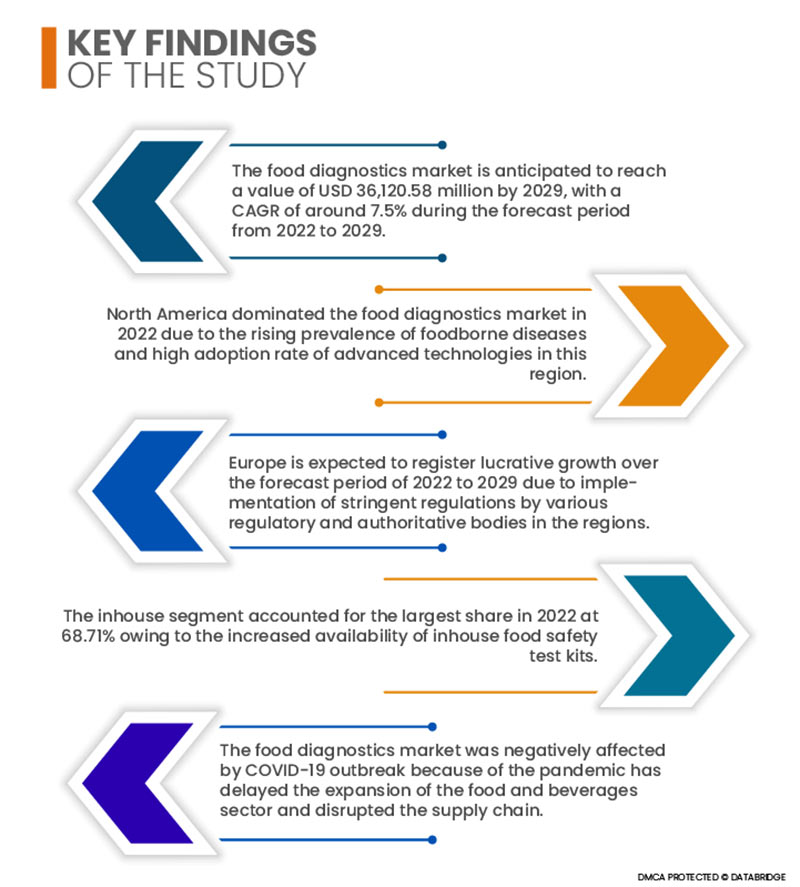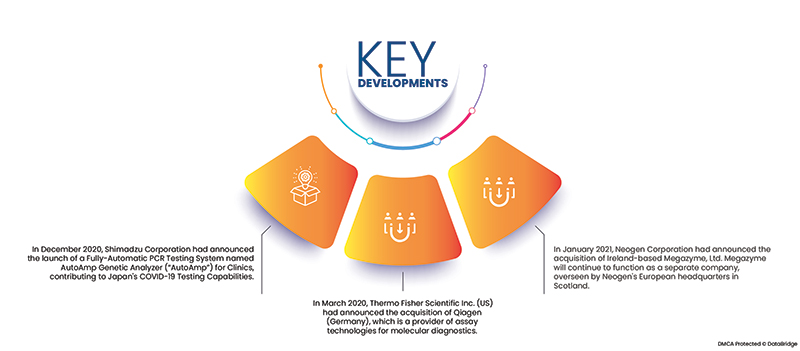Производители продуктов питания, индустрия гостеприимства и розничные торговцы обеспокоены безопасностью и качеством продуктов питания. Производительность зависит от качества и гигиены продуктов питания. Как преднамеренная, так и непреднамеренная фальсификация в последние годы стала высокотехнологичной, и испытательные учреждения могут помочь обнаружить эти фальсификаторы. Лаборатории пищевой диагностики проверяют продукты питания на наличие фальсификаторов, патогенов, остатков пестицидов, химических загрязнителей, таких как тяжелые металлы, микробиологических загрязнителей, неразрешенных добавок, красителей и антибиотиков. Без тестирования продуктов питания производители и изготовители продуктов питания не могут гарантировать, что пестициды, антибиотики, тяжелые металлы и природные яды, среди прочего, отсутствуют. В результате безопасность продуктов питания имеет решающее значение.
Доступ к полному отчету по адресу https://www.databridgemarketresearch.com/reports/global-food-diagnostics-market
Data Bridge Market Research анализирует, что рынок диагностики пищевых продуктов , как ожидается, будет расти в среднем на 7,5% в прогнозируемый период с 2022 по 2029 год и, как ожидается, достигнет 36 120,58 млн долларов США к 2029 году. Растущее число случаев заражения, учащение случаев неправильной маркировки, более высокая распространенность пищевых заболеваний и повышение осведомленности потребителей о безопасности пищевых продуктов — все это стимулирует спрос на диагностическое тестирование. Кроме того, растущий спрос на тестирование остатков пестицидов и других загрязняющих веществ поможет сектору расти быстрее, чем ожидалось.

Ожидается, что рост числа отзывов продуктов питания по всему миру будет способствовать темпам роста рынка в прогнозируемый период.
Рынок, вероятно, будет расти по мере увеличения числа отзывов продуктов питания. Согласно данным Системы быстрого оповещения по продуктам питания и кормам, ожидается, что число отзывов продуктов питания в Европе вырастет на 13% к 2020 году. Из-за увеличения числа отзывов продуктов питания повышенное внимание к микробиологическому качеству и химическому анализу продуктов питания для обеспечения соответствия нормативным требованиям по безопасности продуктов питания привело к росту обеспокоенности по поводу качества и безопасности продуктов питания. В результате принятия законодательства, требующего всестороннего тестирования продуктов питания, резко возрос спрос на диагностику продуктов питания. Эти отзывы выявляют закономерности и общие опасности для безопасности продуктов питания в пищевой промышленности, побуждая к внедрению профилактических мер и стимулируя рост спроса на диагностику продуктов питания.
Область отчета и сегментация рынка
Отчет Метрика
|
Подробности
|
Прогнозируемый период
|
2022-2029
|
Базовый год
|
2021
|
Исторические годы
|
2020 (Можно настроить на 2014 - 2019)
|
Количественные единицы
|
Доход в млн. долл. США, объемы в единицах, цены в долл. США
|
Охваченные сегменты
|
Тип тестирования (система, тестовые наборы и расходные материалы), тип тестов (тестирование безопасности пищевых продуктов, тестирование подлинности пищевых продуктов и рынок тестирования срока годности пищевых продуктов), место проведения (внутреннее и аутсорсинговое предприятие), применение (продукты питания, злаки и зерновые, масличные и бобовые, орехи и напитки)
|
Страны, охваченные
|
США, Канада, Мексика, Китай, Япония, Индия, Южная Корея, Австралия, Сингапур, Таиланд, Малайзия, Индонезия, Филиппины и остальные страны Азиатско-Тихоокеанского региона, Германия, Испания, Франция, Италия, Великобритания, Бельгия, Нидерланды, Швейцария, Россия, Турция, остальные страны Европы, Саудовская Аравия, Южная Африка, Кувейт, ОАЭ, остальные страны Ближнего Востока и Африки.
|
Охваченные участники рынка
|
SGS SA (Швейцария), Thermo Fisher Scientific Inc. (США), PerkinElmer Inc. (США), Shimadzu Corporation (Япония), Agilent Technologies Inc. (США), Randox Food Diagnostics (Великобритания), NEOGEN Corporation (США), ROKA BIO SCIENCE (США), FOSS India Pvt. Ltd. (Индия), Invisible Sentinel (США), Clear Labs, Inc. (США), ALS Limited (Австралия), Ring Biotechnology Co Ltd. (Пекин), Life Technologies (США), bioMérieux SA (Франция), Noack Group (Австрия), Intertek Group plc (Великобритания), Omega Diagnostics Group PLC (Великобритания), Eurofins Scientific (Люксембург)
|
Указатели данных, охваченные отчетом
|
Помимо таких рыночных данных, как рыночная стоимость, темпы роста, сегменты рынка, географический охват, участники рынка и рыночный сценарий, рыночный отчет, подготовленный командой Data Bridge Market Research, включает в себя углубленный экспертный анализ, анализ импорта/экспорта, анализ цен, анализ потребления продукции, патентный анализ и поведение потребителей.
|
Анализ сегмента:
Рынок диагностики пищевых продуктов сегментирован по типу тестирования, типу тестов, месту проведения и области применения.
- На основе типа тестирования глобальный рынок диагностики пищевых продуктов сегментируется на системы, тестовые наборы и расходные материалы. Ожидается, что в 2022 году сегмент систем будет доминировать на мировом рынке диагностики пищевых продуктов с долей рынка 55,18% повысив осведомленность о безопасности пищевых продуктов, качестве и их важности во всем мире.
- На основе типа тестов глобальный рынок диагностики пищевых продуктов сегментируется на рынок тестирования безопасности пищевых продуктов, тестирования подлинности пищевых продуктов и тестирования срока годности пищевых продуктов. Ожидается, что в 2022 году сегмент тестирования безопасности пищевых продуктов будет доминировать на мировом рынке диагностики пищевых продуктов с долей рынка 59,00% из-за возросшей осведомленности о безопасности пищевых продуктов и ужесточения государственных норм в отношении безопасности пищевых продуктов в регионах.
Ожидается , что в 2022 году сегмент испытаний на безопасность пищевых продуктов будет доминировать на рынке диагностики пищевых продуктов .
В 2022 году сегмент тестирования безопасности пищевых продуктов на этом рынке будет доминировать на рынке диагностики пищевых продуктов из-за возросшей осведомленности о безопасности пищевых продуктов и ужесточения государственного регулирования безопасности пищевых продуктов в регионах. Ожидается, что сегмент тестирования безопасности пищевых продуктов достигнет самого высокого среднегодового темпа роста в 7,3% в прогнозируемый период 2022-2029 гг.
- На основе местоположения глобальный рынок диагностики пищевых продуктов сегментируется на внутренние и аутсорсинговые объекты. Ожидается, что в 2022 году внутренний сегмент будет доминировать на мировом рынке диагностики пищевых продуктов с долей рынка 68,71% из-за возросшей доступности внутренних наборов для тестирования безопасности пищевых продуктов.
Прогнозируется , что в 2022 году сегмент внутренних исследований будет занимать наибольшую долю сегмента площадок на рынке диагностики пищевых продуктов.
Ожидается, что в 2022 году сегмент inhouse займет наибольшую долю мирового рынка диагностики пищевых продуктов из-за возросшей доступности наборов для тестирования безопасности пищевых продуктов inhouse. Сегмент inhouse растет со среднегодовым темпом роста 5,4% в прогнозируемый период с 2022 по 2029 год.
- На основе сферы применения глобальный рынок диагностики пищевых продуктов сегментируется на продукты питания, злаки и зерновые, масличные семена и бобовые, орехи и напитки. Ожидается, что в 2022 году сегмент продуктов питания будет доминировать на мировом рынке диагностики пищевых продуктов с долей рынка 36,51% из-за роста случаев фальсификации пищевых продуктов и увеличения числа заболеваний пищевого происхождения.
Основные игроки
Компания Data Bridge Market Research выделяет следующие компании в качестве основных игроков на рынке диагностики пищевых продуктов: SGS SA (Швейцария), Thermo Fisher Scientific Inc. (США), PerkinElmer Inc. (США), Shimadzu Corporation (Япония), Agilent Technologies Inc. (США), Randox Food Diagnostics (Великобритания), NEOGEN Corporation (США).

Развитие рынка
В декабре 2020 года корпорация Shimadzu объявила о запуске полностью автоматической системы ПЦР-тестирования под названием AutoAmp Genetic Analyzer («AutoAmp») для клиник, что вносит вклад в возможности Японии по тестированию COVID-19. Для ПЦР-тестирования с помощью AutoAmp, медицинского устройства класса I, требуется только размещение биологических образцов, дозирующих наконечников, флаконов с реагентами и реакционных сосудов. С набором реагентов для диагностики in vitro Ampdirect 2019-nCoV от Shimadzu этот прибор также может обнаруживать новый коронавирус (SARS-CoV-2).
- В марте 2020 года компания Thermo Fisher Scientific Inc. (США) объявила о приобретении Qiagen (Германия), поставщика аналитических технологий для молекулярной диагностики. QIAGEN — крупный поставщик решений для естественных наук и молекулярной диагностики с 5100 сотрудниками на 35 объектах в 25 странах. В 2019 году выручка компании составила 1,53 млрд долларов. Ее технологии подготовки образцов извлекают, изолируют и очищают ДНК, РНК и белки из различных биологических материалов. Оборудование QIAGEN также можно использовать для автоматизации этих процессов, а ее биоинформатические платформы предлагают клиентам значимую и полезную информацию.
- В январе 2021 года корпорация Neogen объявила о приобретении ирландской компании Megazyme, Ltd. Megazyme продолжит функционировать как отдельная компания под надзором европейской штаб-квартиры Neogen в Шотландии. Приобретение Megazyme корпорацией Neogen естественным и взаимодополняющим образом дополняет их портфель диагностических решений для пищевых продуктов, что соответствует цели предложения всесторонних передовых решений мировым производителям продуктов питания.
Региональный анализ
Географически в отчете о рынке диагностики пищевых продуктов представлены следующие страны: США, Канада, Мексика, Китай, Япония, Индия, Южная Корея, Австралия, Сингапур, Таиланд, Малайзия, Индонезия, Филиппины и остальные страны Азиатско-Тихоокеанского региона, Германия, Испания, Франция, Италия, Великобритания, Бельгия, Нидерланды, Швейцария, Россия, Турция, остальные страны Европы, Саудовская Аравия, Южная Африка, Кувейт, ОАЭ, остальные страны Ближнего Востока и Африки.
Согласно анализу Data Bridge Market Research:
Северная Америка будет доминирующим регионом на рынке диагностики пищевых продуктов в прогнозируемый период 2022–2029 гг.
Северная Америка продолжит доминировать на рынке диагностики пищевых продуктов с точки зрения доли рынка и доходов рынка и продолжит процветать в течение прогнозируемого периода из-за наличия растущего спроса на продукты питания и напитки, в основном обработанные продукты, из-за изменения образа жизни людей в этом регионе. Кроме того, растущая распространенность пищевых заболеваний и высокий уровень внедрения передовых технологий для обнаружения загрязнения пищевых продуктов в этом регионе, как ожидается, будут влиять на темпы роста рынка.
По оценкам, Европа станет самым быстрорастущим регионом на рынке диагностики пищевых продуктов в прогнозируемый период 2022–2029 гг.
Ожидается, что Европа будет расти самыми высокими темпами в прогнозируемый период 2022-2029 годов из-за внедрения строгих правил различными регулирующими и уполномоченными органами в регионах. Великобритания доминирует в европейском регионе из-за возросшего загрязнения мясных продуктов в этом регионе.
Анализ воздействия COVID-19
Влияние пандемии COVID-19 привело к введению карантина в большинстве стран для ограничения передачи вируса, что оказало значительное влияние на каждую отрасль. Из-за вспышки COVID-19 глобальный рост рынка диагностики пищевых продуктов породил большую неопределенность. Основной обязанностью пищевой и безалкогольной промышленности является поддержание циркуляции пищевых продуктов по всей цепочке поставок. Для контроля рисков, связанных с безопасностью пищевых продуктов, и предотвращения загрязнения пищевых продуктов большинство компаний по производству пищевых продуктов внедрили системы управления безопасностью пищевых продуктов (FSMS), основанные на принципах анализа рисков и критических контрольных точек (HACCP), что благоприятно скажется на мировом рынке диагностики пищевых продуктов в ближайшие годы.










